Intel Core i7 4960X (Ivy Bridge E) Review
by Anand Lal Shimpi on September 3, 2013 4:10 AM EST- Posted in
- CPUs
- Intel
- Ivy Bridge
- Ivy Bridge-E
Visual Studio Compile
Our compile test is back and better than ever. With a much larger and faster SSD (Samsung SSD 830, 512GB), we're able to get more consistent compile times between runs. We're now using Visual Studio 2012 to compile Mozilla's Firefox project. The compile is multithreaded however there are periods of serial operation where performance is bound by the speed of a single core. The end result is a benchmark that stresses both single and multithreaded performance. Compile times are reported in minutes elapsed.
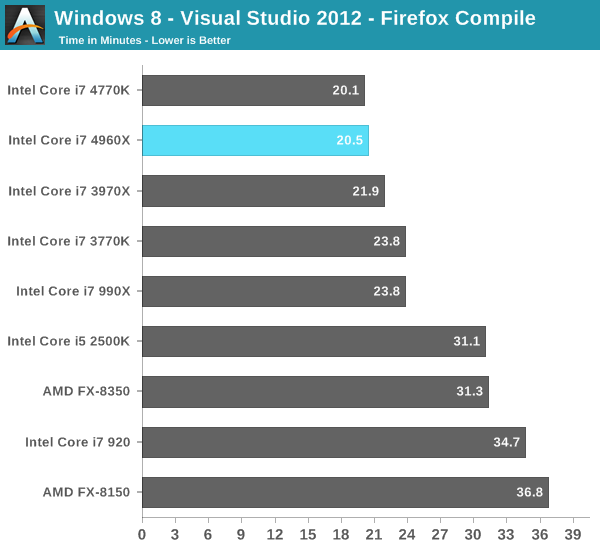
It's clear that IVB-E holds the advantage over Haswell when faced with heavily threaded workloads, but what about those workloads that are a good mix of both light and heavily threaded tasks? A medium-threaded workload if you will. It turns out our Firefox compile test is just that. Haswell's architectural improvements seem to do wonders for this test (under OS X as well), giving the 4770K a 16% lower compile time than Ivy Bridge. IVB-E on the other hand throws more cores at the problem, effectively equaling Haswell's performance but not exceeding it. In this case, if the rest of your applications are better threaded/demand more cores then IVB-E is the right solution for you. If, however, building Visual Studio projects is the most thread heavy thing you do then Haswell is a better option.
Photoshop
To measure performance under Photoshop CS4 we turn to the Retouch Artists’ Speed Test. The test does basic photo editing; there are a couple of color space conversions, many layer creations, color curve adjustment, image and canvas size adjustment, unsharp mask, and finally a gaussian blur performed on the entire image.
Time is reported in seconds and the lower numbers mean better performance. The test is multithreaded.
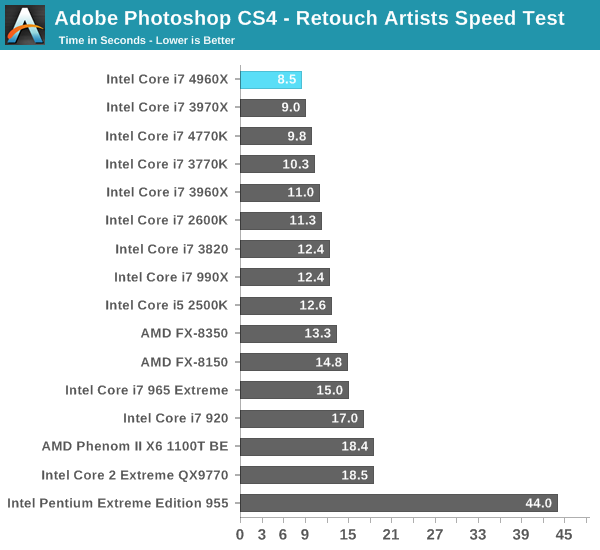
Our Photoshop test provides another example of an application with both lightly and heavily threaded behaviors. In this case, our Photoshop test favors the latter as the 4960X manages a 13% performance advantage over the 4770K. Once again the IVB-E advantage over SNB-E is around 5%.
File Compression/Decompression
The 7-zip benchmark is a CPU bound multithreaded integer workload that looks at 7-zip compression/decompression algorithms where the IO subsystem is removed from the equation:
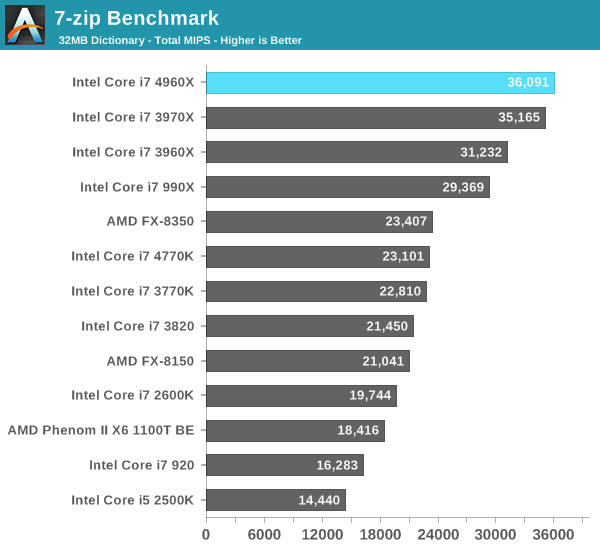
In its biggest advantage so far, the 4960X outperforms the 4770K by 56% in the 7-zip test. The IVB-E performance advantage compared to SNB-E shrinks to under 3% here. Heavily threaded integer workloads are also well suited for AMD's FX architecture. Here the FX-8350 is able to equal Haswell's performance.
Next up is our old Par2 test. Par2 is an application used for reconstructing downloaded archives. It can generate parity data from a given archive and later use it to recover the archive. Chuchusoft took the source code of par2cmdline 0.4 and parallelized it using Intel’s Threading Building Blocks 2.1. The result is a version of par2cmdline that can spawn multiple threads to repair par2 archives. For this test we took a 708MB archive, corrupted nearly 60MB of it, and used the multithreaded par2cmdline to recover it. The scores reported are the repair and recover time in seconds.
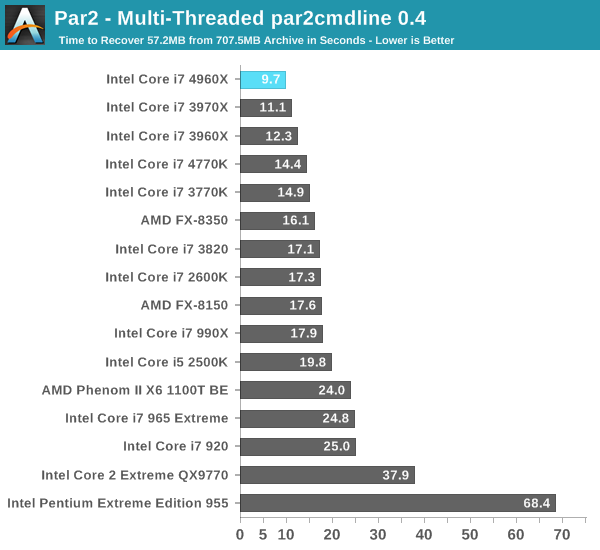
Here's another heavily threaded workload that does very well on the 4960X. We also see a rare situation where IVB-E increases performance over SNB-E by more than 10%.
Excel - Heavy Math
In our final CPU centric test we're running a monte carlo simulation on a large Excel spreadsheet. The process is well threaded.
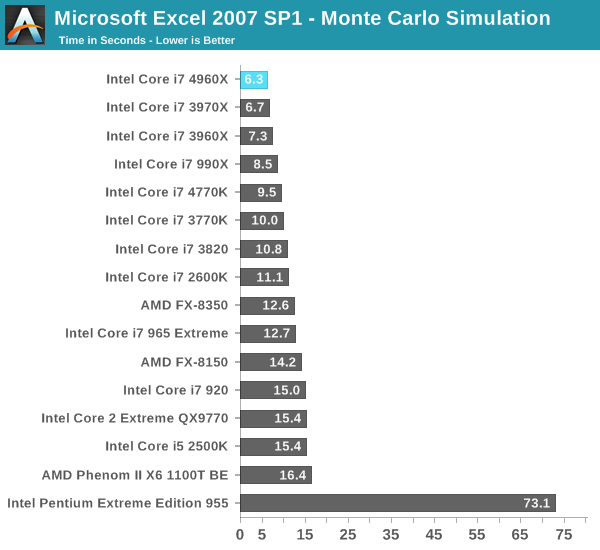
With 50% more cores, the 4960X delivers 33% better performance than the 4770K. If running multithreaded math workloads is up your alley, there's no alternative to the 6-core extreme edition parts.










120 Comments
View All Comments
chadwilson - Tuesday, September 3, 2013 - link
Is the IHS soldered or using the cheap termal material? The issue with desktop IB & Haswell overclockability has been proven to be the cheap thermal material between the chip and IHS. If they have a soldered chip to IHS then this will be a decent upgrade over straight IB.BrightCandle - Tuesday, September 3, 2013 - link
Considering the power consumption, clock speed, overclock and temperature obtained its looking most like this is the same interface as SB-E - ie its soldered. Not that it makes much difference as just like SB-E it doesn't actually overclock all that well compared to its 4 core sibling.MrSpadge - Tuesday, September 3, 2013 - link
Look at the results: temperature is not the main problem any more due to the bigger die, but OC is still not good at 4.3 GHz / 1.4 V. Actually I'd say this is ridiculously bad compared to earlier 22 nm chips (my Ivy can do this at ~1.1 V).And I recently got a 3770K which requires 1.11 V to even hit 4.0 GHz! Seems to me Intels current process is to blame for Haswell OC rather than the thermal paste. Sure, temps drop when replacing the paste.. but OC doesn't improve all that much, does it? And if Ivy and Ivy-E don't clock all that well either...
Shadowmaster625 - Tuesday, September 3, 2013 - link
If SNB-E @ 435 mm^2 fit into 130W then they could have made IVB-E @ 435 mm^2 fit into about the same power envelope. If they had to drop the clocks a couple hundred MHz then that's a small price to pay for 10 cores.Kevin G - Wednesday, September 4, 2013 - link
Actually, the core count for the larger Ivy Bridge-E goes up to 12.adamantinepiggy - Tuesday, September 3, 2013 - link
So do these CPU use actual solder under the lid or crappy paste like the 4770K?noeldillabough - Tuesday, September 3, 2013 - link
Oh I've waiting for this! Now the most important question to me...which motherboard is everyone getting an Ivy Bridge-E going to use? I'm doing a custom water cooled loop if that makes any difference.diceman2037 - Tuesday, September 3, 2013 - link
Anand, that marketing image is suffering from a typo, "18% Lower" refers to power utilized, not performance.DMCalloway - Tuesday, September 3, 2013 - link
Wow! 40 PCIe lanes sounds great until you remember skt. 2011 still only supports two 'true' sata3 ports and no native usb3. PCIe storage is never a smooth experience. It's a shame Intel seems unconcerned with power users that are not enterprised based.randfee - Tuesday, September 3, 2013 - link
What a shame these don't support ECC memory! I want it back for the enthusiast!I'm a scientist, what am I supposed to purchase (privately)? I want a beefy machine for physics simulations at home that run for days/weeks i.e. What if a privat person wants to run several VMs?
The E-series would provide nice performance, but no ECC, what a shame!
Right now one has to pick between speed without ECC (chances are the crashes on you) or a chip with relatively slow performance (clock wise) to get ECC, at the same price point. The highend XEON CPUs are out of the question.
@ Anand, please point out to the Intel representatives you meet that there's a market for this! One has to consider AMD at this point, they offer many threads + ECC for a consumer price point. Granted, they're slower, but the premium for the Intel chips with ECC is just out of proportion for private use.